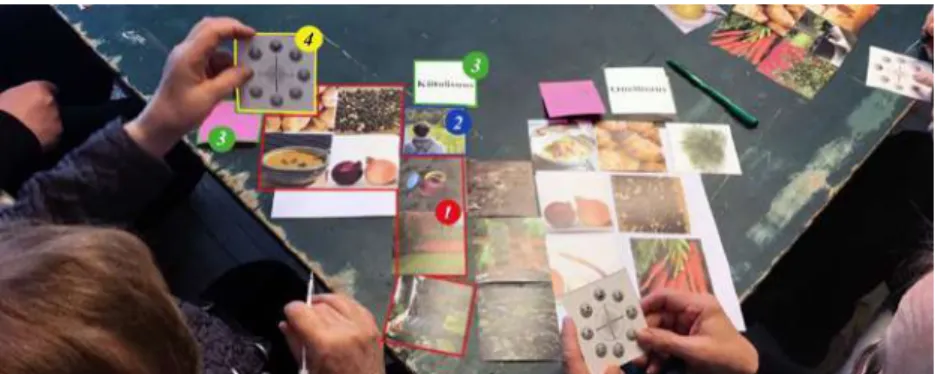Thinkers and optimists believe that all regions of the world can achieve human development goals. We thank all the authors who chose INTERACT 2019 as the place to publish their research, all the judges and the INTERACT 2019 accepted and offered 9 workshops from the submissions.
A Storytelling-based Approach to Designing for the Needs of Ageing People
Similarly, Papanek [14] emphasizes that the designer's role is to focus on people's needs rather than their desires. Improving the clarity of the design process that designers propose to senior users participating in the co-design process.
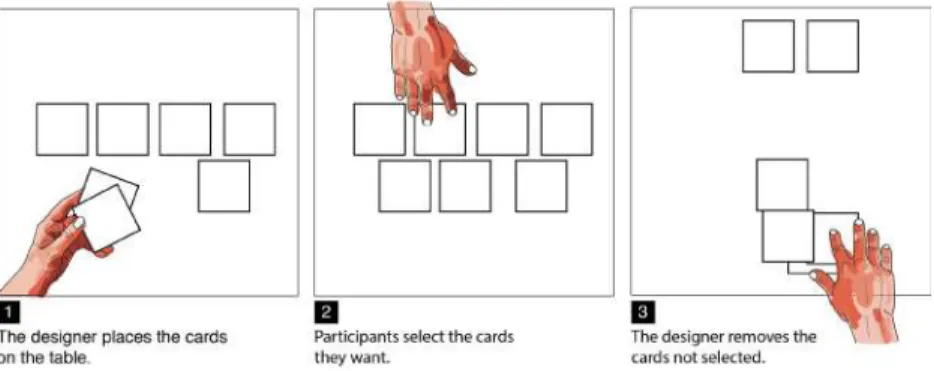
Breaking Interaction Barriers
Monitoring Elderly in Natural Settings Exploiting Everyday Objects
More than 25 years ago, Mark Weiser's vision greatly influenced research into ubiquitous computing, envisioning that "the most potentially interesting, challenging, and profound change implied by the ubiquitous computing age is a focus on composure." [1]. The RFID stick reads data on the RFID tag, i.e. the tag's unique identifier, and sends it over the network to the server application.
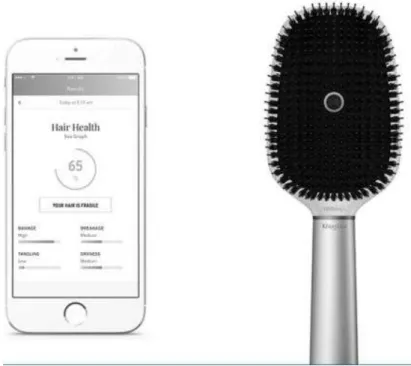
A Value-sensitive Toolkit: Bringing Values into the Design Process when Designing
This motivated us to provide value cards with short definitions of the values for the next edition of the workshops. The aim of the workshop was to test the value review session with the categorized value lists.
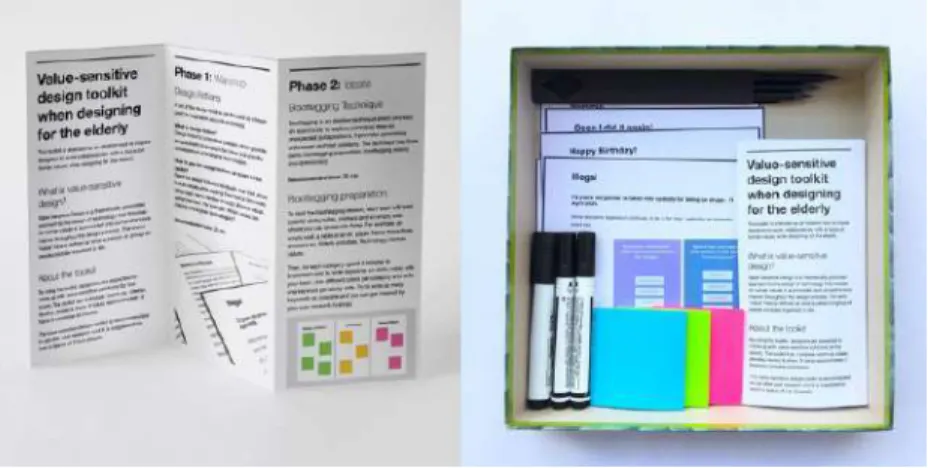
The Sailboat Exercise as a Method for User Understanding and
Requirements Gathering
Including end users in the design process allows for effective requirements gathering and increases both user satisfaction and the level of acceptance of the final design [1]. Thus, the results of the sailboat exercise make an important contribution to inform the design, particularly phases 2 and 3 of the design process (Fig. 1).
![Fig. 1: User-centered design process, adapted from ISO 9241-210:2010 [7].](https://thumb-ap.123doks.com/thumbv2/1libvncom/9202422.0/41.646.133.517.687.875/fig-user-centered-design-process-adapted-iso.webp)
Challenging Misinformation
Exploring Limits and Approaches
Misinformation and
User-Generated content: Applying participatory journalism practices in
Maniou, T., Panagiotidis, K., & Veglis, A.: The politicization of selfie journalism: an empirical study of parliamentary elections. Maniou, T., & Bantimaroudis, P.: Hybrid Salience: Investigating the Role of Traditional and Digital Media in the Rise of the Greek Radical Left.
Navigating through real and fake news by using provenance information
By modeling social media artifacts as nanopublications, the provenance information can be used as a means of establishing trust in that artifact. The provenance aspect would be a new element and social media users should be aware of the change.
Disinformation online: potential legal and regulatory ramifications to the right
This environment potentially undermines the exercise of the right to free elections and poses significant risks to the functioning of a democratic system. 2 The positive obligations of the state that guarantee the right to free elections: what role for public scrutiny. Protecting voters' personal data from microtargeting misuse is the next subject of public action.
Arguably, the positive obligations of the state in ensuring the enjoyment of the right to free elections mean that the enforcement of the obligations imposed on platforms should not be left to the discretion of their providers.
Democratic Policy-making for
Misinformation Detection Platforms by Git-based Principles 1
Governments and public institutions are using Git-based frameworks for open co-creation of computer code as well as codified text (laws and policies). Our approach proposes a decentralized and horizontal git-based framework for disinformation policymaking in an online platform. We provide the environment for test users by creating a Git-based social media platform.
This position paper proposes a git-based framework for developing misinformation platform policies in a decentralized and collaborative manner.
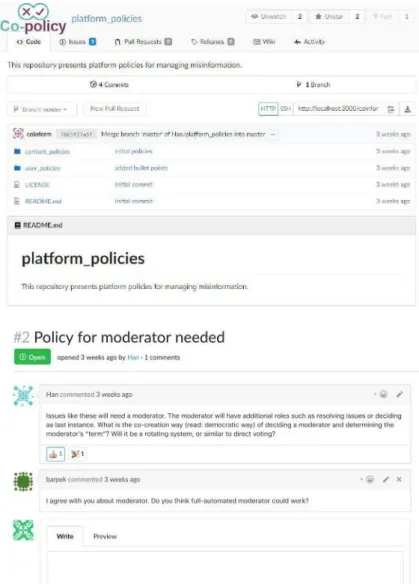
DisMiss False Information
A Value Matter
Mobile computing, social media and social applications have connected people and made all kinds of information available like never before. If on the one hand social media and social applications have contributed to democratizing access to information and communication technology (ICT), on the other hand they promote disinformation and the spread of disinformation, catalyzing social and cultural changes, sometimes with harsh and undesirable consequences . For marketing purposes, mobile carriers usually do not limit data usage for social media applications such as WhatsApp and Facebook, but they do charge for access to other online services.
The cultural characteristics of a people, the values they share and the beliefs they hold have a great influence on the way they understand and use social media.
Socially Acceptable HCI
Social Acceptability of Emerging Technologies and
On Social Acceptance of UI
Intervention Mechanisms on Posting and Reading Comments on Online News
In addition, when someone starts writing a comment, a similar visualization of the expected responses (from different types of people) begins to form (see Fig. 1 right). 2 shows only three types of labels (an overall positive response, "this is explosive" and "I love this"), the vocabulary of labels can be very vague. The design tries to solve the problem that there is no explicit information on the emotional content of the comments.
The discussion could begin to resemble more synchronous communication, but without the advantage of a face-to-face multimodal channel.
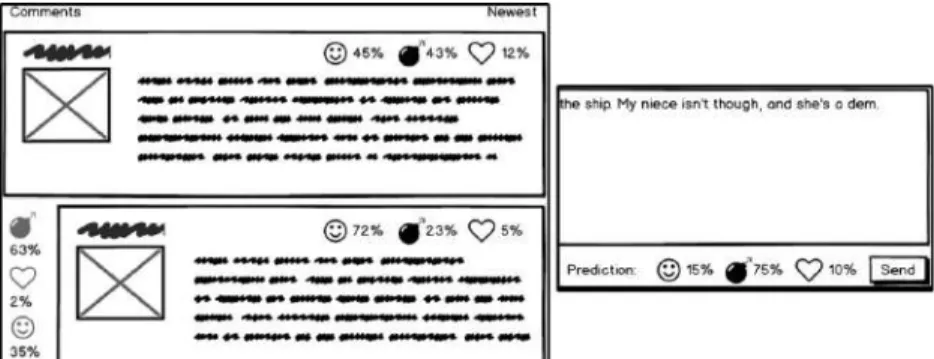
What Smartphones, Ethnomethodology, and Bystander Inaccessibility Can Teach
Us About Better Design?
This knowledge is not rooted in detached reflection of the deep nature of social action. It is crucial to be able to rely on the shared understanding of the social situation as. Because they do not know what the activity of the smartphone user is, the other participants in the social situation are also in the dark about the "good enough" knowledge about the nature of the situation as a whole.
What people accept or do not accept is the way technology enters the situation as part of a web of social activity.
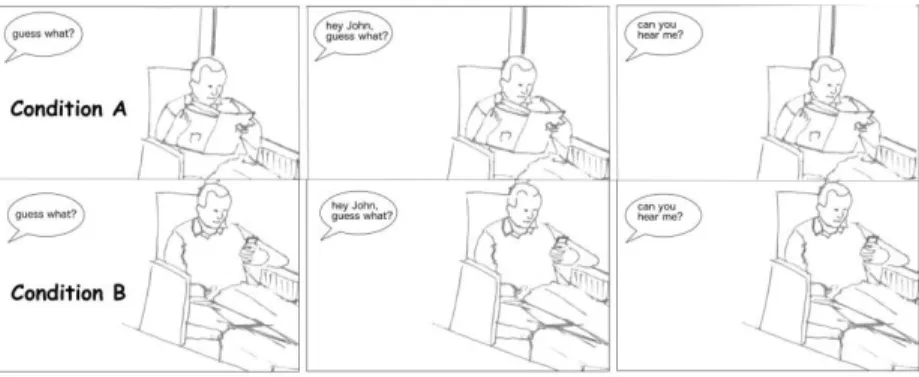
A Scenario Generator for
Evaluating the Social Acceptability of Emerging Technologies
Since users can be noticed or even observed by other individuals who - consciously or unconsciously - want to recognize their attitudes, goals and intentions, interacting with devices in public can affect the user's impression management and - consequently - the social acceptability of the interaction [1]. In: Proceedings of the 20th International Conference on Human Computer Interaction and Mobile Devices and Services. Denning, T., Dehlawi, Z., Kohno, T.: In situ with augmented reality glasses observers: perspectives on recording and privacy mediating technologies.
I: Proceedings of the 11th International Conference on Human-Computer Interaction with Mobile Devices and Services.
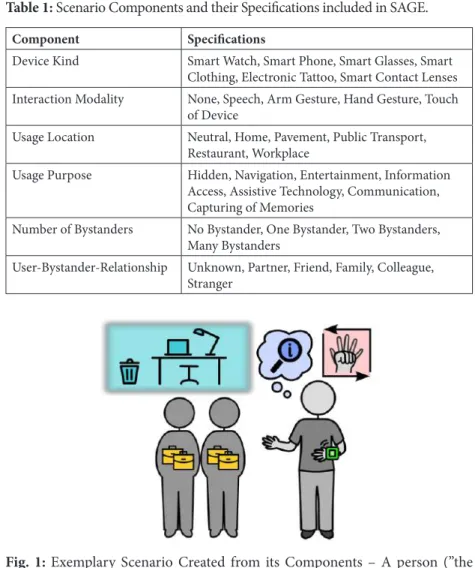
Social Acceptability, Obstructions, Collaboration and Embarrassment
However, with a turnstile that resembled social items like Blender and Heads Up of The Table, all participants found the artifact challenging for their movements. Second, many of the students who conceived and implemented these interventions reported great initial embarrassment before the public implementation of their experiments. And third, the sense of embarrassment was profound when we as researchers sat down to watch video recordings of several of the interventions.
I: Proceedings of the 5th Student Interaction Design Research Conference (SIDeR): Flirting with the Future, pp.
Is Going Unnoticed More Socially Acceptable?: An Exploration of the
Our results indicate that social acceptance and noticeability of the health and fitness tracking device are negatively correlated when i) the device is larger and ii) the device is worn around the chest specifically by female users. Our study is inspired by this research, and we investigated the relationship between users' social acceptance and the perceptibility of the device. The second and third sections assessed the social acceptability and noticeability levels for different sizes of fitness equipment and on body locations, respectively.
The level of social acceptance was negatively correlated with noticeableness only when the unit was larger (rs = −.43, N = 32, p <.01).

User Experiences and Wellbeing at Work
User Experience at Work
Four Perspectives on What It May Mean
It is only in the event of a breakdown that the tool becomes the focus of the user's attention - becomes present at hand. However, the user must not attribute the positive UX to the tool, but in whole or in part to other aspects of the usage situation. This means that the users' work is measured in the same way as that of the automated components.
In both cases, the medium stands in the way of interactions between users.
Prototype Design of Alert Device for Hearing Impaired Users
There are various kinds of devices available for hearing-impaired users, such as assistive devices, amplifying devices, and alarm devices [8]. This device should be portable and should detect all the desired non-speech sounds for hearing impaired users. This research paper provides an overview of the research process and a related paper prototype design of the alarm device for hearing impaired users in their work environment at home.
Thus, the proposed warning device is designed with the main goal of helping hearing-impaired users to detect sounds occurring in the home environment.
![Table 1: Grades of hearing impairment (dBHL: decibels Hearing Level)[12].](https://thumb-ap.123doks.com/thumbv2/1libvncom/9202422.0/143.646.94.473.736.867/table-grades-hearing-impairment-dbhl-decibels-hearing-level.webp)
The “aftermath” of Industry 4.0 in Small and Medium Enterprises
This article aims to analyze the main components inherent in Industry 4.0, the benefits of its implementations and understand the main differences between SMEs and MNEs. As mentioned above, SMEs due to their small size face a huge constraint due to their lack of resources, both physical and financial [11]. The main reason behind this low percentage can be explained by the fact that “SMEs lack confidence in information security and data protection.
From the analysis carried out in this paper in relation to Industry 4.0 and the main characteristics of small and medium-sized enterprises and multinational companies, it is possible to understand the main reasons supporting the lack of investment in new technologies.
![Table 1: Advantages of implementing Industry 4.0 [9–10].](https://thumb-ap.123doks.com/thumbv2/1libvncom/9202422.0/150.646.92.548.122.383/table-advantages-of-implementing-industry.webp)
Experience Design for Work Tools
This means that the designers must not only define functional, but also experiential goals to design for. We have focused on the means to set experience goals [8] and to exploit these goals during the design process 6, 11. From this main goal, different experience goals can be defined for the different phases of the episode plot.
The frameworks for designing long-term experiences provide an inspiring foundation for setting experiential goals.
User Persona of Mother of Preterm Neonate
This generates an important gap in the understanding of mothers of premature neonates and their hospitalization in neonatal intensive care units (NICU). These mothers therefore face an increased mental stress, which is highlighted in the hypothesis. In the future, an Android application will be developed for the mothers of premature neonates considering their user personality obtained during this research work.
Heidari, H., Hasanpour, M., Fooladi, M.: The Iranian parents of premature infants in the NICU experience shame stigma.
Opportunities for recommended mental health strategies to reduce stress at work
They concluded that there is currently not enough research evidence to support the effectiveness of mental health apps. A large group of patients (one control group) was asked to use a web-based recommendation service that recommended mobile applications for mental health and wellness for four weeks. Therefore, we argue that research on how to increase employee adherence to mental health therapies is crucial in a new research agenda.
Bakker, D., Kazantzis, N., Rickwood, D., Rickard, N.: Mental health smartphone apps: review and evidence-based recommendations for future developments.
Livability – Analysis of People’s Living Comfort in Different Cities of India Using
GIS: A Prototype
Score or Standardization. This method classifies the data points across the median which helps in interpreting whether a given point has a positive/
The above methods are used to calculate the livability index for different cities, which is also incorporated in the tool we have proposed for livability analysis. It shows the liveability index for that location and also shows each indicator rating in bar chart format. In figure-1, upper right corner shows Jaipur City's livability index and the bar graph represents the indicators' ratings.
The present work is inspired by a web portal 'AARP Livability Index' [12], which aims to include analysis for Indian regions.
Identification of Crop Disease using Augmented Reality-based Mobile App for
Indian Farmers: A Prototype
Currently there are various methods used by farmers to identify crop disease like taking help from farmer's friend, pesticide shop person, expert advice from agriculture officer or scientist or agronomist. Image capture of crop leaves through the camera is matched to the online database of crop diseases. Now a days most of the farmers use smartphone [3], this crop disease prediction mechanism through mobile application using AR technology would be convenient and easily available to the farmers.
Therefore, we are developing an augmented reality mobile application for crop disease prediction.

We ask ourselves questions: How can "Digital Peer-Tutoring" form of learning enable workers to design positive UX for themselves and their colleagues. We report on the initial phase of a research project to develop digital peer mentoring for retail workers. Peer mentoring [4, 8] overlaps somewhat with other notions of informal peer-to-peer technical assistance, such as face-to-face learning [11], direct guidance in tertiary education [2] and peer support. learning [5].
What distinguishes 'digital peer tutoring' from traditional peer tutoring is that the concept is based entirely on the use of video.
Proposed System for a Socio- technical Design Framework for Improved
User Collaborations with Automation Technologies
Currently, "automation" is one of the main means of supporting operators using systems with high complexity. The increasing integration of IoE into the industrial value chain has set the stage for this revolution [8]. In human-machine collaboration, the value of information is now more recognized given the great power of machine decision-making in highly automated systems.
Motivating users to engage with new technologies remains a challenge due to a lack of understanding of individual end-user experiences and interactions with such technologies.
Human(s) in the Loop Bringing AI & HCI
Designing a Machine Learning-based System to Augment the Work Processes of
Medical Secretaries
